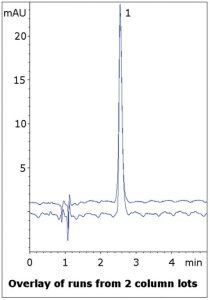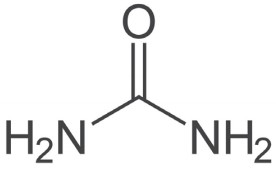Retention of Urea, a Highly Polar Compound
Urea is very difficult to retain by conventional HPLC methods. It is highly polar and therefore shows little or no Reversed Phase retention. However, this Method shows how it can be readily retained past the solvent front using a simple isocratic Mobile Phase. Furthermore, the Peak shape for the compound is symmetrical and does not exhibit tailing or fronting. Data from two Column lots is shown in the overlay, illustrating the Robustness of the Method.

 Peak:
Peak:
Urea
Method Conditions
Column: Cogent Diamond Hydride™, 4µm, 100Å
Catalog No.: 70000-7.5P
Dimensions: 4.6 x 75mm
Mobile Phase: 5% DI Water / 95% Acetonitrile / 0.1% (v/v) Trifluoroacetic Acid (TFA)
Injection vol.: 1µL
Flow rate: 1.0mL / minute
Detection: UV @ 205nm
Sample Preparation: 1mg / mL Urea reference standard in diluent of 50% Acetonitrile / 50% DI Water / 0.1% TFA
t0: 0.9 minutes
Note: There is a growing demand for a reliable procedure for the determination of Urea in many matrices such as milk, soil extracts, seawater, and wine. In addition, there are several common approaches for measurement of Urea involving detection of Ammonia (after hydrolysis) by enzymatic or colorimetric methods. HPLC is the most specific Method but either organic Normal Phase or ion-pair Reversed Phase are generally required for retention.
Attachment
No 229 Urea Analyzed with HPLC pdf 0.4 Mb Download File


